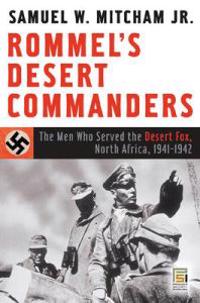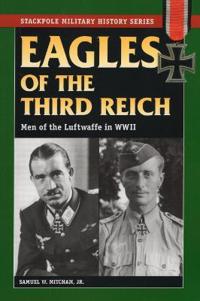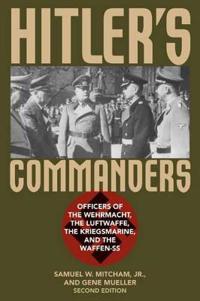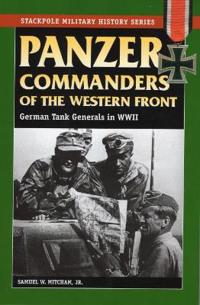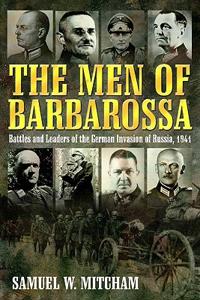Rommel's Desert Commanders (Inbunden)
avSamuel W. Mitcham
ISBN: 9780275994365 - UTGIVEN: 2007-02Perhaps the most famous and admired soldier to fight in World War II was Field Marshal Erwin Rommel, who achieved immortality as the Desert Fox. Rommel's first field command during the war was the 7th Panzer Division-also known as the Ghost Division-which he led in France in 1940. During this campai[...]
Blitzkrieg No Longer: The German Wehrmacht in Battle, 1943 (Inbunden)
avSamuel W. Mitcham
ISBN: 9780811705332 - UTGIVEN: 2009-12A pivotal year of World War II through German eyes The campaigns of the German army, air force, and navy described by a master storyteller Covers the aftermath of Stalingrad, Kursk, Tunisia, Sicily, Italy, the U-boat war, and air battles After a crushing loss at Stalingrad, the German war machine re[...]
The German Defeat in the East, 1944-45 (Pocket)
avSamuel W. Mitcham
ISBN: 9780811733717 - UTGIVEN: 2007-01The last place a German soldier wanted to be in 1944 was the Russian front. That summer, Stalin hurled more than 6 million men, 9,000 tanks, 16,000 aircraft, and 12,800 guns and rocket launchers against German forces. Despite this gigantic effort and the resulting decimation of German forces, events[...]
Retreat to the Reich (Pocket)
avSamuel W. Mitcham
ISBN: 9780811733847 - UTGIVEN: 2007-01The Allied landings in Normandy on June 6, 1944, marked the beginning of the German defeat in the West. Military historian Samuel W. Mitcham, Jr., vividly recaptures the desperation of the Wehrmacht as its thin gray line finally snapped amidst brutal hedgerow-to-hedgerow fighting in Normandy and as [...]
The Battle of Sicily (Häftad)
avSamuel W. Mitcham, Friedrich von Stauffenberg
ISBN: 9780811734035 - UTGIVEN: 200707In July 1943, the Allies launched a massive amphibious assault on Sicily. The invasion proved successful, bringing fame to American General George S Patton and British General Bernard Montgomery, whose 'race' to Messina was immortalised in the movie "Patton". But according to Mitcham and Stauffenber[...]
Eagles of the Third Reich (Pocket)
avSamuel W. Mitcham
ISBN: 9780811734059 - UTGIVEN: 200707From its secret post-World War I beginnings to its virtual destruction by the Allied air forces, the story of the German air force is best told by examining its leaders - brilliant, ambitious, ruthless, and deceitful men like Hermann Goering, the drug-addicted Luftwaffe commander; Erhard Milch, the [...]
Rommel's Desert War (Häftad)
avSamuel W. Mitcham
ISBN: 9780811734134 - UTGIVEN: 200708In a series of battles marked by daring raids and quick-armoured thrusts against a numerically superior enemy, Erwin Rommel, the notorious Desert Fox, and his Afrika Korps waged one of World War II's toughest campaigns in the North African desert in 1942. The Axis campaign climaxed in June with the [...]
German Order of Battle (Häftad)
avSamuel W. Mitcham
ISBN: 9780811734165 - UTGIVEN: 200709This is the first of 3 definitive volumes that cover the German ground forces that swept across Europe with such ruthless efficiency in 1939 and 1940 and battled the Allies around the globe until the bitter end in 1945. Taken together, these volumes are the most comprehensive and accessible referenc[...]
German Order of Battle (Häftad)
avSamuel W. Mitcham
ISBN: 9780811734370 - UTGIVEN: 200709This second of 3 volumes on German ground forces in World War II covers the 291st through 999th Infantry Divisions; named infantry divisions (e.g., Division von Manteuffel and Division Sicily); jaeger, light, and mountain divisions; security divisions; and Luftwaffe ground divisions, including parac[...]
German Order of Battle (Häftad)
avSamuel W. Mitcham
ISBN: 9780811734387 - UTGIVEN: 200710The final volume of Samuel Mitcham's trilogy on the German Army in World War II focuses on panzer, panzer grenadier, motorised, and Waffen SS divisions. Among these units are the 1st SS Leibstandarte Adolf Hitler Division, whose members included tank ace Michael Wittmann; the notorious 12th SS Hitle[...]
Panzers in Winter (Häftad)
avSamuel W. Mitcham
ISBN: 9780811734561 - UTGIVEN: 200802Before dawn on 16 December 1944, German forces rolled through the frozen Ardennes in their last major offensive in the west, thus starting the Battle of the Bulge, which would become the U.S. Army's bloodiest engagement of World War II. Catching the Allies by surprise, the Germans made early gains, [...]
The Desert Fox in Normandy (Pocket)
avSamuel W. Mitcham
ISBN: 9780815411598 - UTGIVEN: 2001-09Appointed by Hitler to defend Nazi-held France against an imminent Allied invasion, Field Marshall Erwin Rommel saw how poor German defenses were when he arrived in Normandy in 1943. Rommel's growing awareness of the Allies' battle plans and his organization of the defense forces come into sharp foc[...]
Hitler's Commanders (Häftad)
avSamuel W. Mitcham, Gene Mueller
ISBN: 9781442211537 - UTGIVEN: 201210Despite huge odds against them, Hitler's commanders-the elite of the Wehrmacht-almost succeeded in conquering Europe. Now in an expanded edition that includes biographies of the generals of Stalingrad and a new chapter on the panzer commanders, this book offers rare insight into the men who ran Nazi[...]
The Rise of the Wehrmach (Inbunden)
avMitcham, Samuel W
ISBN: 9780275996413 - UTGIVEN: 2008-06-30"The Rise of the Wehrmacht" is the first comprehensive work to deal with the German war effort in World War II from this point of view. Its uniqueness lies in the fact that it covers the entire war effort from the point of view of the German military that actually conducted and fought the war, somet[...]
Panzer Commanders Of The Western Front (Pocket)
avSamuel W., Jr. Mitcham
ISBN: 9780811735070 - UTGIVEN: 200807This work features detailed biographies of 5 panzer commanders. It describes what it's like to lead tank units in battle. This work covers D-Day, Normandy, the campaign for France, the Battle of the Bulge, and the final battles in Germany. Generals like Heinz Guderian have received most of the credi[...]
Rommel's Desert Commanders (Pocket)
avSamuel W., Jr. Mitcham
ISBN: 9780811735100 - UTGIVEN: 200808This work: offers a new perspective on the most famous campaign of the legendary Desert Fox; provides details on the contributions and animosities of Rommel's subordinates; and, includes accounts of Tobruk, Gazala, El Alamein, and other battles. In Libya and Egypt in 1941 and 1942, German Field Mars[...]
The Siegfried Line (Pocket)
avSamuel W., Jr. Mitcham
ISBN: 9780811736022 - UTGIVEN: 200910The battles for the Germans' last line of defence in World War II, including Arnhem, Aachen, the Huertgen Forest, and Metz. Built as a series of forts, bunkers, and tank traps, the West Wall - known as the Siegfried Line to the Allies - stretched along Germany's western border. After D-Day in June 1[...]
The Men of Barbarossa (Inbunden)
avSamuel W., Jr. Mitcham
ISBN: 9781935149156 - UTGIVEN: 201002The story of history's greatest military operation and the commanders who nearly led it to success . . .This book not only tells the story of Operation Barbarossa but describes the expertise, skills, and decision-making powers of the men who directed it. The result is an illuminating look at the per[...]

